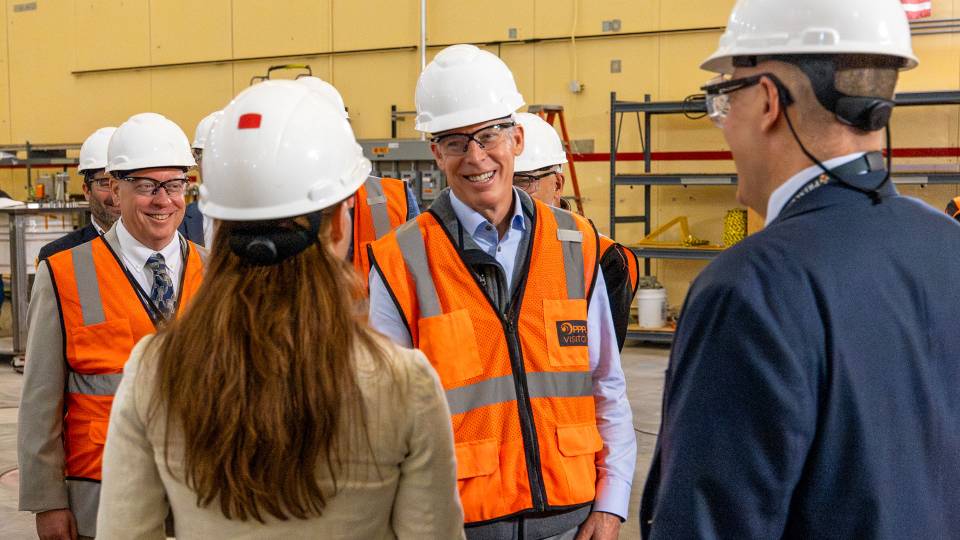A new initiative is emerging at the Princeton Plasma Physics Laboratory (PPPL), the U.S. Department of Energy national laboratory managed by Princeton University. Under the direction of principal engineer Yuhu Zhai, PPPL is building its new High-Field Magnet Test Facility, which will provide powerful magnets for scientific experiments to researchers at both PPPL and the University, as well as private companies along the mid-Atlantic coast.
The new magnet lab will build electromagnets producing magnetic fields ranging from three to five teslas and beyond. To get a sense of how strong these magnets are, consider that a magnetic field of just one tesla is 20,000 times more powerful than the strength of Earth’s magnetic field at its surface. The magnet lab’s research could lead to stronger, more efficient, affordable magnets for doughnut-shaped devices known as tokamaks that confine plasma, the electrically charged state of matter consisting of electrons and atomic nuclei. Scientists around the world are trying to use plasma to harness fusion, the process that powers the sun and stars, to generate electricity without producing greenhouse gases or long-lived radioactive waste.
Special magnets for special projects
Unlike the permanent magnets that hold art to a refrigerator door, electromagnets derive their properties from the flow of electricity through wires. Such magnets typically require exotic materials known as superconductors that conduct electricity best when they are cooled to temperatures hundreds of degrees below zero using liquid helium. Instead of using this technique, Zhai and his colleagues plan to cool the superconductors using a more advanced technique known as conduction cooling, which relies on transferring heat from an object by placing it in direct contact with another object. These magnets will also feature large central tunnels, or bores, about 2.5 feet in diameter, that will allow scientists to use larger probes in their research and generally give researchers easier access to high magnetic fields for their experiments.
“I am thrilled that the High-Field Magnet Test Facility is now open,” Zhai said. “This is truly a momentous time for PPPL.”

Yuhu Zhai leads PPPL’s new High-Field Magnet Test Facility, a collaborative research space open to researchers in both academia and private industry. The lab will enable the design and construction of sophisticated magnets to aid research in a range of fields, including fusion energy and particle physics.
Searching for a hidden cosmos
One of the magnet lab’s first projects involves building a magnet for a Princeton University device that will test a hypothesis about the fundamental nature of dark matter, strange stuff invisible to human senses and instruments that could make up about 25% of the universe. (The mysterious dark energy makes up 70%, and regular matter makes up the remaining 5%.) The researchers are hunting for tiny, never-before-observed particles called “axions.”
The magnet PPPL will build for the device, which is known as Princeton Axion Search (PXS), will generate a field of about five teslas and have a bore with a diameter measuring just under 3 feet. PXS is being led by Princeton's James S. McDonnell Distinguished University Professor in Physics Lyman A. Page Jr. and Assistant Professor of Physics Saptarshi Chaudhuri. “We are very much looking forward to working with Yuhu’s group at PPPL to build the magnet for PXS,” Page said. “His design is one of the two central pieces of the experiment and, I’m sure, key to the success of the proposal.”
PXS will generate a strong magnetic field that turns axions into photons, the particles that make up light. The Princeton scientists aim to detect that light using sophisticated equipment, indirectly confirming the axion hypothesis. Along with the PPPL-built magnet, PXS will include the light detectors, computers that analyze the data, and a large container holding all the elements and maintaining the low temperatures needed for the equipment to operate properly. “We would like to turn PXS on in three or four years and then operate for another three or four years, all the while continuously gathering data and publishing papers,” Chaudhuri said.
Detecting axions will be difficult in part because of the almost inconceivably small numbers involved. Axions are thought to have masses a million billion times smaller than a proton, one of the particles that make up the center of an atom, and the light produced when an axion encounters a magnetic field could be four septillion times weaker than that produced by a typical light bulb. “These amounts are fantastically tiny, but recent technological advances make detecting axion light possible,” Chaudhuri said.

An image from the James Webb Space Telescope of a galaxy cluster named “SMACS 0723.3Ð7327.” Galaxy clusters form near enormous knots of dark matter, the strange stuff that holds the material universe together. The gravity of these dark matter knots pulls together an enormous amount of regular matter, too, which eventually forms bright galaxies and stars.
Expanding capabilities and portfolios
The success of the dark matter magnet project will have ramifications both for PPPL’s engineering capabilities and its research portfolio. “This demonstrates that PPPL can support both in-house and external projects, as well as play a role in the world of high-energy particle physics in the cosmic frontier,” Zhai said. “It will also demonstrate that we can build magnets strong enough to form the basis for future doughnut-shaped fusion devices known as tokamaks, perhaps even strong enough for future fusion demonstration power plants. This is indeed an exciting time.”
PPPL is mastering the art of using plasma — the fourth state of matter — to solve some of the world's toughest science and technology challenges. Nestled on Princeton University’s Forrestal Campus in Plainsboro, New Jersey, our research ignites innovation in a range of applications including fusion energy, nanoscale fabrication, quantum materials and devices, and sustainability science. The University manages the Laboratory for the U.S. Department of Energy’s Office of Science, which is the nation’s single largest supporter of basic research in the physical sciences.





